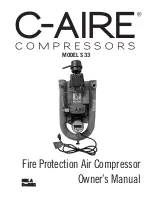
EN
144
is best to leave drain valve open until such
time as it is to be used. This will allow
moisture to completely drain out and help
prevent corrosion on the inside of tank.
3.
Risk of fire or explosion.
Do not spray
flammable liquids. Spray area must be well
ventilated. Keep compressor away from
the spraying area and all explosive vapors.
4.
Risk of bursting.
Do not adjust regulator
to result in output pressure greater than
marked maximum pressure of attachment
and/or the item being inflated. Never use at
pressure greater than 10 bar.
5.
Use an air pressure gauge periodically
while inflating an item to check the air
pressure.
6.
The machine must be connected to a
circuit protection device (fuse or circuit
breaker).
The protection device shall be
set at 7 A current, and the user shall do
necessary test according to clause 18.2.2
of EN 60204-1:2006 to check if the pro-
tection device is suitable for use.
7.
Avoid touching hot or cold surfaces.
During operation the cylinder head heats
up and the outlet cools down.
8.
To reduce the risk of electric shock, do
not expose the machine to rain (water)
or dust; store it indoors.
9.
Inspect tank before operation for rust,
pin holes, or other imperfections that
could cause it to become unsafe.
Never
weld or drill holes in the air tank.
10.
Make sure the hose is free of obstruc-
tions or snags.
Entangled or snarled hos-
es can cause loss of balance or footing and
may become damaged.
11.
Use the air compressor only for its in-
tended use.
Do not alter or modify the unit
from the original design or function.
12.
Always be aware that misuse and im-
proper handling of this tool can cause
injury to yourself and others.
13.
Never step or stand on the compressor.
Following this rule will reduce the risk of
serious personal injury.
14.
Never leave a tool unattended with the
coiled air hose attached.
15.
Do not operate this tool if it does not
contain a legible warning label.
16.
Do not continue to use a tool or hose
that leaks air or does not function prop-
erly.
17.
Always disconnect the power supply
and air supply before making adjust-
ments, servicing a tool, or when a tool
is not in use.
18.
Do not attempt to pull or carry the air
compressor by the hose.
19.
Your tool may require more air con-
sumption than this air compressor is
capable of providing.
20.
Always follow all safety rules recom-
mended by the manufacturer of your
air tool, in addition to all safety rules
for the air compressor.
Following this
rule will reduce the risk of serious personal
injury.
21.
Never direct a jet of compressed air to-
ward people or animals.
Take care not
to blow dust and dirt towards yourself or
others. Following this rule will reduce the
risk of serious injury.
22.
Do not use this air compressor to spray
chemicals.
Your lungs can be damaged by
inhaling toxic fumes. A respirator may be
necessary in dusty environments or when
spraying paint. Do not carry while painting.
23.
Inspect tool cords and hoses periodical-
ly and, if damaged, have them repaired
at your nearest HORNBACH Store.
Con-
stantly stay aware of cord location. Follow-
ing this rule will reduce the risk of electric
shock or fire.
24.
Check damaged parts.
Before further
use of the air compressor or air tool, a
guard or other part that is damaged should
be carefully checked to determine that it
will operate properly and perform its in-
tended function.
25.
Check for alignment of moving parts,
binding of moving parts, breakage of
parts, mounting, and any other condi-
tions that may affect its operation.
A
guard or other part that is damaged should
be properly repaired or replaced by an au-
thorized service center. Following this rule
Содержание PE-3050
Страница 18: ...DE 18...
Страница 36: ...FR 36...
Страница 54: ...IT 54...
Страница 104: ...CZ 104...
Страница 122: ...SK 122...
Страница 140: ...RO 140...












































